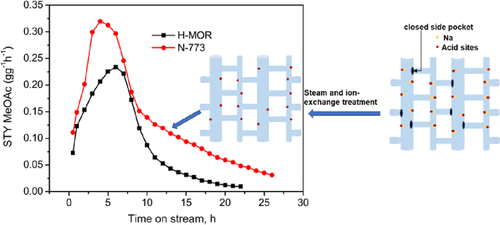当前位置:
X-MOL 学术
›
Ind. Eng. Chem. Res.
›
论文详情
Our official English website, www.x-mol.net, welcomes your feedback! (Note: you will need to create a separate account there.)
Effect of Steam Treatment on the Properties of Mordenite and Its Catalytic Performance in a DME Carbonylation Reaction
Industrial & Engineering Chemistry Research ( IF 4.2 ) Pub Date : 2022-01-18 , DOI: 10.1021/acs.iecr.1c04184 Feng Xu 1, 2 , Jiangang Lv 2 , Chong Chen 2 , Zhe Hong 1 , Guoqing Zhao 1 , Lei Miao 1 , Weimin Yang 2 , Zhirong Zhu 1
Industrial & Engineering Chemistry Research ( IF 4.2 ) Pub Date : 2022-01-18 , DOI: 10.1021/acs.iecr.1c04184 Feng Xu 1, 2 , Jiangang Lv 2 , Chong Chen 2 , Zhe Hong 1 , Guoqing Zhao 1 , Lei Miao 1 , Weimin Yang 2 , Zhirong Zhu 1
Affiliation

|
A series of dealuminated mordenite (MOR) samples with different acidities and various porosities were prepared through steam treatment of H+/Na+ mordenite. The obtained zeolites were elaborately characterized by X-ray diffraction, N2 adsorption–desorption, scanning electron microscopy, 29Si nuclear magnetic resonance (NMR), 27Al NMR, NH3 temperature-programmed desorption, and Fourier transform infrared spectroscopy, and the catalytic performance for dimethyl ether (DME) carbonylation was investigated. The characterization results revealed that the kind of cation balancing the zeolite charge had a great effect on the crystalline structure and acidity of mordenite zeolite during steam treatment and ion-exchange processes. Dealumination was observed both on Na-MOR and H-MOR, but it was much milder on the Na-MOR zeolite comparatively. After Na-MOR was treated with steam, its structure was well-preserved, but side pockets of mordenite were opened, resulting in an increased microporous volume and strong acid sites. Interestingly, it was found that the removal of framework Al in the 12MR channel was favored over the 8MR channel during steaming of Na-MOR, leading to the mordenite to possess more acid sites in the 8MR channel compared with those in the 12MR channel. As for the steamed H-MOR, both the crystalline structure and porosity were obviously damaged, resulting in a decreased microporous volume and acidity. The influence was more significant in the 8MR channel of H-MOR due to the obvious removal of framework Al and blockage of side pockets. The performance tests revealed that Na-MOR treated with steam was an effective way to enhance the catalytic performance for DME carbonylation reaction. The N-773 catalyst (steamed with Na-MOR at 773 K) showed a methyl acetate product rate of 0.33 gg–1 h–1, which was much higher than that of the parent H-MOR (0.23 gg–1 h–1). Moreover, the dealuminated catalyst exhibited a slow deactivation rate, which was possibly ascribed to the reduced strong acid sites in the 12MR channels. Although the steam treatment of H-MOR resulted in a lower activity in the DME carbonylation reaction, it exhibited a higher MeOAc selectivity and improved stability for its overall decreased acidity.
中文翻译:

蒸汽处理对丝光沸石性能及其在二甲醚羰基化反应中催化性能的影响
通过对H + /Na +丝光沸石进行蒸汽处理,制备了一系列具有不同酸度和不同孔隙率的脱铝丝光沸石(MOR)样品。得到的沸石通过X射线衍射、N 2吸附-脱附、扫描电子显微镜、29 Si核磁共振(NMR)、27 Al NMR、NH 3进行了精细表征。程序升温脱附,傅里叶变换红外光谱,以及二甲醚(DME)羰基化的催化性能进行了研究。表征结果表明,平衡沸石电荷的阳离子种类对蒸汽处理和离子交换过程中丝光沸石的晶体结构和酸度有很大影响。在 Na-MOR 和 H-MOR 上均观察到脱铝现象,但在 Na-MOR 沸石上相对温和得多。Na-MOR经过蒸汽处理后,结构保存完好,但丝光沸石的侧袋被打开,导致微孔体积增加和强酸性位点。有趣的是,发现在蒸煮 Na-MOR 过程中,12MR 通道中骨架 Al 的去除优于 8MR 通道,导致丝光沸石在 8MR 通道中比在 12MR 通道中具有更多的酸性位点。蒸煮后的H-MOR晶体结构和孔隙率均受到明显破坏,导致微孔体积和酸度降低。由于骨架Al的明显去除和侧袋的阻塞,H-MOR的8MR通道的影响更为显着。性能测试表明,用蒸汽处理的Na-MOR是提高二甲醚羰基化反应催化性能的有效途径。N-773 催化剂(在 773 K 下与 Na-MOR 一起蒸煮)显示乙酸甲酯产物率为 0.33 gg 导致微孔体积和酸度降低。由于骨架Al的明显去除和侧袋的阻塞,H-MOR的8MR通道的影响更为显着。性能测试表明,用蒸汽处理的Na-MOR是提高二甲醚羰基化反应催化性能的有效途径。N-773 催化剂(在 773 K 下与 Na-MOR 一起蒸煮)显示乙酸甲酯产物率为 0.33 gg 导致微孔体积和酸度降低。由于骨架Al的明显去除和侧袋的阻塞,H-MOR的8MR通道的影响更为显着。性能测试表明,用蒸汽处理的Na-MOR是提高二甲醚羰基化反应催化性能的有效途径。N-773 催化剂(在 773 K 下与 Na-MOR 一起蒸煮)显示乙酸甲酯产物率为 0.33 gg–1 h –1,远高于母体 H-MOR (0.23 gg –1 h –1 )。此外,脱铝催化剂表现出较慢的失活速率,这可能归因于 12MR 通道中强酸位点的减少。尽管 H-MOR 的蒸汽处理导致 DME 羰基化反应的活性降低,但它表现出更高的 MeOAc 选择性并提高了其整体酸度降低的稳定性。
更新日期:2022-01-26
中文翻译:

蒸汽处理对丝光沸石性能及其在二甲醚羰基化反应中催化性能的影响
通过对H + /Na +丝光沸石进行蒸汽处理,制备了一系列具有不同酸度和不同孔隙率的脱铝丝光沸石(MOR)样品。得到的沸石通过X射线衍射、N 2吸附-脱附、扫描电子显微镜、29 Si核磁共振(NMR)、27 Al NMR、NH 3进行了精细表征。程序升温脱附,傅里叶变换红外光谱,以及二甲醚(DME)羰基化的催化性能进行了研究。表征结果表明,平衡沸石电荷的阳离子种类对蒸汽处理和离子交换过程中丝光沸石的晶体结构和酸度有很大影响。在 Na-MOR 和 H-MOR 上均观察到脱铝现象,但在 Na-MOR 沸石上相对温和得多。Na-MOR经过蒸汽处理后,结构保存完好,但丝光沸石的侧袋被打开,导致微孔体积增加和强酸性位点。有趣的是,发现在蒸煮 Na-MOR 过程中,12MR 通道中骨架 Al 的去除优于 8MR 通道,导致丝光沸石在 8MR 通道中比在 12MR 通道中具有更多的酸性位点。蒸煮后的H-MOR晶体结构和孔隙率均受到明显破坏,导致微孔体积和酸度降低。由于骨架Al的明显去除和侧袋的阻塞,H-MOR的8MR通道的影响更为显着。性能测试表明,用蒸汽处理的Na-MOR是提高二甲醚羰基化反应催化性能的有效途径。N-773 催化剂(在 773 K 下与 Na-MOR 一起蒸煮)显示乙酸甲酯产物率为 0.33 gg 导致微孔体积和酸度降低。由于骨架Al的明显去除和侧袋的阻塞,H-MOR的8MR通道的影响更为显着。性能测试表明,用蒸汽处理的Na-MOR是提高二甲醚羰基化反应催化性能的有效途径。N-773 催化剂(在 773 K 下与 Na-MOR 一起蒸煮)显示乙酸甲酯产物率为 0.33 gg 导致微孔体积和酸度降低。由于骨架Al的明显去除和侧袋的阻塞,H-MOR的8MR通道的影响更为显着。性能测试表明,用蒸汽处理的Na-MOR是提高二甲醚羰基化反应催化性能的有效途径。N-773 催化剂(在 773 K 下与 Na-MOR 一起蒸煮)显示乙酸甲酯产物率为 0.33 gg–1 h –1,远高于母体 H-MOR (0.23 gg –1 h –1 )。此外,脱铝催化剂表现出较慢的失活速率,这可能归因于 12MR 通道中强酸位点的减少。尽管 H-MOR 的蒸汽处理导致 DME 羰基化反应的活性降低,但它表现出更高的 MeOAc 选择性并提高了其整体酸度降低的稳定性。


























 京公网安备 11010802027423号
京公网安备 11010802027423号